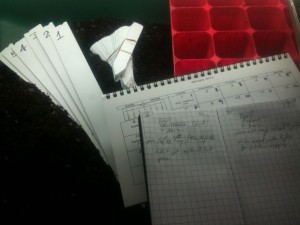 |
| Crucial elements of the seed starting/plant tracking system |
Looking over a 20-plus-year career in gardening and farming, I realize that these days, having less free time than I ever have had in my life, the only way I am able to keep up with things in the various gardens I tend is through the magic of systems. Systems cut time not because I want to spend less time gardening – after all it is a very pleasurable and healthful activity, right?, and that is to be desired, sought out, and prolonged if at all possible – but systems represent a kind of elegance in gardening, and in other areas, where I intuitively know I have streamlined a form, made it beautiful and elegant and effective, and therefore I now prefer it to my now-perceived prior obtuse bunglings. With good systems, I am not just sufficient to the tasks I used to be able to do, but I can actually perceive more deeply, innovate better, AND take less time to do it. With so much else running downhill in life, thank goodness that with a bit of observation and effort one can actually improve on one’s results.
That said, systems certainly don’t need to be complicated or very technological. The photo above illustrates the system I have evolved to track my plants from seeding to harvest. While a well-grown vegetable is a fine thing, some well-kept data is very fine, too, and while you can’t eat data, you can certainly improve your vegetable harvest with it. Here are the elements of the system which will yield a valuable harvest of data on your garden:
1. A calendar. This can be just the one your heating company drops off as a courtesy or something fancy you buy. This year I am using a continuous number system for my planting records, which will make it easier to tell how many days processes like transplant to harvest actually take without a lot of counting. If I said I seeded a crop on Feb. 21 and then harvested it on Nov. 2, could you quickly tell me how many days that took? Nope, but if I said I seeded it on day 52 (which is Feb. 21 on my continuous calendar) then harvested it on day 306 (Nov. 2, continuous calendar) , the number 254 would just leap out at you, wouldn’t it? To make a continuous calendar I just took my regular calendar, and with a Sharpie I marked each day as one higher than the previous. Of course all the days of January have the same number as their calendrical date, but Feb. 1 is #32 and so on from there.
2. A journal. I got some really keen 3″x 5″ journals recently, and I’m giving a page for each crop seeded. Each page gets a cardinal number, usually for a particular tray that I’m planting of the same crop. If I am dividing a tray between two crops (which could be two different varieties of basil, say), then each different thing gets its own number and page. I also record the date of planting, or in my case the continuous calendar day number ( for example January 1 is Day 1), the general name of the crop (Lettuce), the specific variety (Bambi), the seed source (Johnny’s or just J) and the year of the seed. I ususally also record the type of tray I am using (such as a 28 cell tray or a plain 11″x22″ flat) and the potting mix.
That should only take a bit of the top of each page, with the rest of the space being left to document the progress of the crop. It’s kind of like a scrap book which has lots of information from childhood (think seeding), a little bit from adolescence (transplant date), a note or two on adult achievements (performance notes), and then a final obit (harvest data).
The most crucial part in all of this is the sequential number on the top of the page, because this number will follow the planting through its lifespan.
3. Small plastic tags. These cost about 2 cents a piece, but are crucially important to identify what was planted and when. They can be written on with a pencil and simply erased or washed after use for long cycles of reuse. On these I put the crucial identifying number, the day number (abbreviated as D25, for example, ) the general and varietal name of the crop.
4. Large plastic tags. These are about 25 cents a piece, but well worth it, allowing you to transfer key data to your outdoor plantings, so you can go through the garden with your little seed-room notebook from time to time and gather the precious data that will reward you so well during your winter planning. These large plastic tags I pre-number in order because each planting will get one when it moves outdoors or wherever is its final home. Like the small tags, they are eminently reusable. I’ve got 100 numbered for the coming season, figuring that by the time I go through planting a hundred different things, some of the shorter-season stuff will have already yielded itself up and its tag will be available for reuse.
Being verbose is not something to be sought after as a blogger, so I’m going to cut this post here. There is more to tell about the system, and hopefully the soon-to-be-told rest of the story will keep you coming back.
